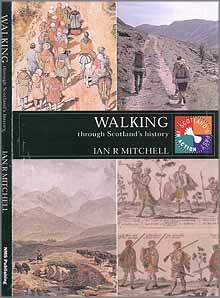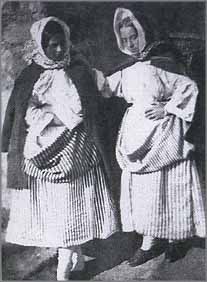Walking through Scotland's history

Walking through Scotland's History - Ian Mitchell's latest book is published by the National Museums of Scotland and is expected to be in book stores by August or September. Anyone interested in Scotland, it's history and walking with love this book. It covers a lot of territory and includes the pilgrims, the Roman Legions, the Jacobites, tinkers, drovers and today's hill walkers. The chapter on Women Walking is fascinating and I am delighted to include it on the Web site.(June, 2001).
Women Walking, Mostly
The walking tales of war, scientific exploration and commerce outlined have involved men. That women were capable of pedestrian achievements is shown by the fictional account given in Scott_s Heart of Midlothian, of Jeanie Deans_ barefoot walk from Edinburgh to London in the early eighteenth century seeking a pardon for her sister. There are many examples from real life to show that Jeanie_s feat on foot was not beyond her sisters then and later.
Scottish fisherfolk were often cut off socially from the rest of the country which could begin at their garden dyke. Womenfolk never went to sea, but their shore lives were hard, even after they had carried their menfolk to the boats to prevent them getting their clothes wet! (Not as sexist as it seems; men would have little chance of drying their clothes once at sea.). Collieston fishwives near Aberdeen walked three miles and back to the Ythan estuary, and then far out at low tide to the mussel scaups to collect fresh bait, several times a week. Once the fish was unloaded, it fell to the fishwives to sell it. From the east-coast fishing ports until the early part of the last century, women would walk carrying creels, often weighing a hundredweight, up to 30 miles a day to their markets, selling the fish or bartering them for meal and eggs. The Old Statistical Account of the 1790s records that the fishwives of Dunbar walked the 27 miles to Edinburgh with 200 pounds of fish in five hours, though that is difficult to credit. From Dunbar inland to Lauder in the Borders runs the Herring Road, used by the fishwives heading to their rural customers. Those who had the hardest walk were undoubtedly the fishwives of Whaligoe in Caithness. Even before their attempts to sell the fish, they had to climb, carrying their creels, the 330 steps in the cliff from the harbour to the road, howked out by the local laird to help the fishing.
The fishwives of the North-East coastal ports of Inveralochy, Cairnbulg and Broadsea had things well-organised. Christian Watt was born in 1833 and later recalled how she went with her mother to the 'inland country_ every year with cured fish in the 1840s and 50s _ even selling to the Royal Family at Balmoral. They organised a carter to transport 10 tons of fish to a bothy at Corrybeg on upper Deeside, where they lived in primitive conditions, and to which they walked. There they stayed for several weeks, scouring the Grampians around on foot with their creels; Christine recalled that on occasion they would have problems as local stalking estates tried to block their progress through the glens. Fishwives were fearsome creatures, vituperative and given to swearing; but every account states their morality was impeccable, and many were religious revivalists. Gradually the walking fishwife disappeared. Scotland_s last working fishwife, Betty Millar of Musselburgh, died in 2000. Though she still wore traditional fishwives garb, her journeys to the Border towns where she sold her fish were done by train.
A change in the organisation of Scottish fishing took place with the herring boom of the nineteenth century. From half a million, the number of barrels exported rose to a million between 1850 and 1900. In 1880, there were about 40,000 employed directly in the fishing in the season, with another 50,000, mainly women, engaged on the shore side of the industry. The fishquines followed the seasonal migration of the silver darlings down the east coast of Scotland from Shetland and Wick, to the Moray Firth ports, and latterly as far south as Yarmouth in England. Although a much more capitalist industry than white fishing was originally, it took some time before walking was eliminated from the herring. Labour was seasonal, and had to get to the east-coast ports from regions of labour surplus, which were mainly in the western Highlands. In the season, the population of Wick doubled, many of the incomers arriving from the west coast; and before railways and other public transport, they walked. Islanders, from Lewis especially, took the ferry to the mainland, and joined those from the west of Ross-shire and Sutherland, heading mainly for Wick, a walk which took them a week. There the men engaged on the herring boats, and the women took employment in the curing. Conditions were terrible. People slept in insanitary bothies twelve to fifteen to a room, the stench in the streets - 'putrescent effluvia from fish offal_ - was indescribable, and typhoid fever was acute and common amongst the workers. Huge amounts of whisky were drunk, as much as 500 gallons a day in Wick in the local pubs, 'Seminaries of Satan and Belial_ as one minister described them. The Highlanders were not popular, and serious riots erupted between them and local fishermen in Wick in 1828, to be repeated on a greater scale in 1859, where a three-day riot led to troops being dispatched to the port to restore order.
Though Wick was the most favoured location, many Highlanders walked even further to the Moray coast ports, as this account from 1848 demonstrates:
The fishermen on this eastern coast go out about the middle of Julyengaging extra hands, mainly Highlanders, who hire themselves to the owners of the boats for six or eight weeksJust before the herring boats go out the roads are dotted with little groups of Highlanders, each man having a small parcel of necessaries tied up in a handkerchief and carried on a stick over his shoulder. They are sadly footsore and wayworn by the time they have traversed the island from the west coast (as) the hard roads try them severely. Very little English is spoken amongst them.Wearily and heavily the poor fellows labour along the road (to) Forres, Nairn and the other towns near the shore
Although this account talks of men, it is clear that the majority who went were women. For example, in 1914 3,000 women went from Lewis to the herring, and about 1,600 men, a combined total of 20% of the island.s population. As the Fishery Officer in Stornoway put it in 1887, '.the annual migration from the Lews has been increasing.every man and woman who was without regular employment went (to the herring)_ Latterly the Lewis people went by steamer to Kyle, and then by railway to Wick or Aberdeen - whence they took the boat to Shetland, but the railhead did not reach Kyle till 1897, so the tradition of walking to the herring must have continued long after 1848.
The herring industry never recovered fully from the crisis caused by the Great War. The annual migration of fisher-lassies continued, but now by train and steamer. The accounts of the interwar period show that, though the economic motive was vital in their seasonal migration, these trips were undertaken as a working holiday, a female-bonding ritual where they could express themselves more freely than in the regular life of the enclosed male-dominated fishing community. That must have been the case for their nineteenth-century predecessors as well.
The fishing was not the only Scottish industry which formerly relied heavily on seasonal labour. Farming, especially at harvest time, could not do without migrant workers, and many of these came surprisingly large distances to and from their employment on foot. Large numbers came from the impoverished Highlands to the hairst. Highland harvesters, or shearers, appear regularly in accounts from 1750, and in 1824 2500 turned up to be hired at the hiring fair at the Cross in Glasgow. A minister fulminated in 1827 about the roads of Argyll being occupied by scores of Highland women returning from the hairst, after spending their wages on fripperies and finery, and having been away from restraining moral influences (of males) the while. That for the girls it was a holiday as well as necessary work is shown by the fact that larger groups often took a piper with them, to play on the road, or while they were at work. There was strength in numbers, and often groups of 30, 40 or 50, known to each other, would sign up for the hairst, and live together in communal bothies while they laboured. Female labour was favoured as well into the nineteenth century the harvesting implement was the light-toothed sickle, which women could wield, and their bending ability enabled them to cut the grain to the root.
The Lothian hairst attracted labour from Argyll, but also from very far afield. A commentator in Wester Ross in 1844 noted of the local girls that 'Many went for the harvest. Some as far as the Lothians._ There 46% of the labour force in agriculture was female, higher than elsewhere in Scotland. In the 1880s the Napier Commission on Crofting noted that there was no abatement in this tradition of seasonal migration, 'Many young women went to the Lothians. It is sheer necessity that compels them to go._ While it seems that going to the herring was a long-term pursuit, with many married women involved, the shearers in the Lothians appear to have been mainly in their mid to late teens. Further labour came from an unexpected area, the agricultural North-East, where the climate meant the harvest arrived later, and gangs of workers could earn money in the Lothians, working their way back northwards in time for the hairst in the northern lands.

While waiting for the grain to ripen in the cold shoulder of Scotland, many embarked at Aberdeen to sail to Leith for the Lothians. The gangs collected at Aberdeen came from mony airts and pairts, as the following obituary in the Glasgow Herald of 1923 indicates:
The death has taken place at Tiniver, Dufftown, Bafffshire of Mr John Gordon who on February 2nd celebrated his 99th birthday. A native of the parish of Grange, Banffshire, he entered farm service at an early age, and when a young man would walk to Aberdeen, and proceed by boat to Leith to engage in the Lothian harvests.
Another who sailed from Aberdeen but walked there, was the young woman from Deeside, who wrote the ballad, The Lothian Hairst, in the 1860s. Once in Lothian, the workers walked from farm to farm - 'For sax lang weeks the country roon / Fae toon tae toon we went._ The group was under the charge of a foreman, Logan, who as well as ensuring the lassies worked, had to prevent them engaging in dalliance with the local lads, clearly much to the regret of the sangstress:
My mate and I could get nae chance
For Logan_s watchfu eye
And wi the lads we got nae sport
For Logan was sae sly
Clearly, the independence and adventure of the hairst counted with the lassies almost as much as did the pay of about £1.00 a week at harvest time, and songs abound of the association of the hairst with romance and courting. It would not appear from these songs that the shearers shared the strict moral code of the fisher lassies. While the latter would sing of their hope that their anchor would hold in the storms of life, the former were more likely to express a wish that a ploughboy might wrap them in his plaidie. But with men like Logan policing the living quarters, they had little chance. The shearers lived in farm outbuildings in some cases, but as time passed bothies were specially constructed for them. These generally had no running water, and no toilet, though a fire and coals were generally provided; some had stone floors, some earth. Though living conditions were generally poor, the hairst workers, unlike general farm labourers outside hairst time, appear to have been well fed, with porridge, milk, bread, beer and meat provided by the farmer, in addition to the wages.
North-East harvesters moved from farm to farm in the Lothians, then worked the harvest peripatetically northwards towards Stirling, the Carse of Gowrie, Fife, or even westwards to the West of Scotland where it came later than the Lothians. Some would make their own way back to the North-East, and it was probably one such group that Victoria saw, when she was crossing the old drove road from Deeside to Fettercairn in 1860, over the shoulder of Mount Keen. This route would have been the most direct back from central Scotland for seasonal workers from Upper Deeside. Victoria encountered the group resting prior to their crossing of the mountain, at the foot of the Ladder Burn:
We crossed the burn at the bottom where a picturesque group of 'shearers_ were seated, chiefly women, the older ones smoking. They were returning from the south to the north, whence they came.
The fact that some of the women were smoking must have appalled Victoria, who detested the habit. A common concern amongst contemporary commentators is the loss of social and sexual control over mobile women earning wages.
The introduction of Irish male labour, with the scythe-heuk, contributed to the decline of female shearing. The scythe could cut more and faster than the sickle, but not so well, and male labour was more expensive. But was still a demand for seasonal female labour in the Lothians in 1900. However, with other opportunities opening up for women, they were gradually voting with their feet and abandoning farm labour, despite increased wages offered. Though many still trudged between farms for the hairst, few, if any, actually walked to the Lothians, given the spread of the railway system by this time. The bands of shearers and fisher lassies, groups of women laughing and singing as they escaped for a few weeks to earn their tocher and have some fun, had left the roads.
Reading. "The Fisher Lassies" in Odyssey:the Second Collection. ed. Billy Kay
- (1982) describes the interwar period, but working conditions had
hardly changed in a century.
"The Lothian Hairst" in Bothy Songs and Ballads, ed. John Ord
(n.d.) p.264. Frustrated female eroticism.
Places to visit.
Aberdeen Maritime Museum
Walks to do:
The Herring Road. Dunbar to Lauder 28 miles.(O.S.67 and 73)
Scottish Hill Tracks, p.31.
Firmounth A Rights of Way case in 1930 established that this route from Aboyne to Tarfside in Glen Esk had seen " a con-siderable body of travelling farm hands going south to the harvesting and shearing." Scottish Hill Tracks, p.96 (O.S. 44)
Read about Ian Mitchell







